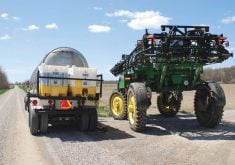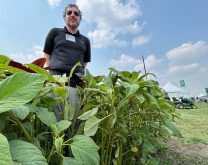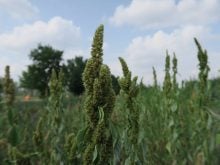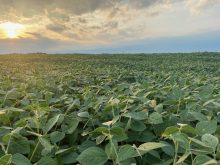An Ontario soy expert says growers should plant at least three varieties to help find the best fit for their farm
WINNIPEG — Horst Bohner is convinced that farmers should plant more than one variety of soybeans.
If they don’t, they are making a “mistake.”
“As a basic starting point, I think every grower should seed at least three varieties. Every year. As a minimum. Hopefully more than that,” said Bohner, the soybean specialist for the ministry of agriculture, food and rural affairs in Ontario.
Bohner spoke about soybeans, yields and management of the crop at the Manitoba Agronomists Conference, held mid-December at the University of Manitoba.
Read Also

Bio-fumigation may become new use for mustard
Mustard is great on hot dogs, but innovators in Western Canada have developed a new mustard variety for a different market — bio-fumigation.
“Essentially, that (seeding more than one) is the difference between the guys… who are moving forward and the guys who call me up and say: ‘I’m frustrated with my soybean yield.’ ”
To support his argument, Bohner showed a bar graph on soybean yield gains from 1942 to 2022 in Ontario.
The average yield gain over the 80 years was 0.36 bushels per year.
When that 0.36 bu. is compared to soybean variety trials in Ontario, the data indicates that most of the gain comes from plant genetics.
“When we plot our variety trials over the years, and they go back to the 1960s, the average response (increase) there is 0.33 bu.,” he said.
That suggests that 90 percent of yield gain, year over year, comes from genetic improvement.
“We don’t have exact numbers to tease that out. It’s a best estimate,” Bohner said.
That doesn’t mean on-farm practices like seeding date, fertility and weed control are meaningless.
If a grower gets those practices wrong, there will be an impact on yield.
But choosing the right variety could be the most important decision.
If a producer selects only one variety and grows it across the entire farm, how do they know it’s the optimal variety for their farm? For their soil and region?
“That’s what I’m trying to push against (planting one variety). I think that’s a big mistake,” Bohner said following his talk.
Planting three or four varieties doesn’t “guarantee more bushels,” Bohner added.
But it could add bushels and will help a grower understand what works on their farm.
“You will spread your risk. It doesn’t have to be 30 percent — 30, 30 and 30,” he said. “But you should, for your own learning, have a few varieties in there…. It’s a nuisance. Let’s be honest. (But) it’s a good practice.”
Selecting the right genetics is crucial, but in recent years Ontario and Manitoba soybean growers have been changing some of their agronomic practices.
In many parts of Ontario, producers are moving away from no-till soybeans.
A big reason is huge corn yields.
If a farmer tries to plant soybeans following a 220 bu. corn crop, managing the corn stalks becomes a massive challenge.
“I’m not a big fan of tillage for soybeans. But I am a huge proponent of dealing with the residue…. Heavy residue is the enemy of big soybean yields. That’s just the way it is,” said Bohner.
“Most, at least where I am in Perth County, have given up altogether on a true no-till. They’ve gone back to some form of incorporation. Whether it is a high-speed disc, or vertical tillage.”
In Ontario and Manitoba, soybean growers have changed or will soon change their practices to control weeds.
For many years, producers relied solely on glyphosate to keep their weeds in check.
Those days are over.
“At one time, people would just spray it and forget about it. Now, you spray, go back and see if you have any misses,” said Dennis Lange, the soybean and pulse specialist with Manitoba Agriculture, who also spoke at the agronomists conference.
Lange showed a map illustrating how waterhemp, first discovered in Manitoba in 2017, has rapidly spread across the province
“We now have 22 confirmed (municipalities) that have waterhemp. It’s a little scary when you walk out there and see those fields.”
Almost all waterhemp in Manitoba is resistant to glyphosate and some may be resistant to multiple herbicides. It is designated as a Tier 1 noxious weed in Manitoba, so it must be destroyed when found.
Waterhemp can be managed, but soybean growers and other farmers need to adapt.
In 2023, some producers didn’t adapt and they ran into problems.
“What was very common this year from growers that did have issues with waterhemp… they were using Enlist soybeans or the Xtend soybeans,” Lange said.
Those products tolerate two or three types of herbicides. Enlist beans have tolerance for glyphosate, 2,4-D choline and also glufosinate. Xtend beans can tolerate glyphosate, dicamba and glufosinate.
“Instead of putting that application (a second herbicide) on early in the season, they just sprayed glyphosate,” Lange said. “Then, all of a sudden, they gave us a call (when) waterhemp plants were up to (their) knees…. Glyphosate only, can run you into problems.”
















